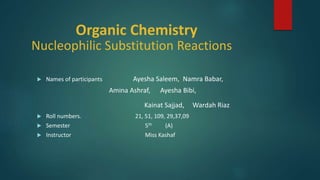
Nucleophilic substitutions reactions
- 1. Organic Chemistry Nucleophilic Substitution Reactions Names of participants Ayesha Saleem, Namra Babar, Amina Ashraf, Ayesha Bibi, Kainat Sajjad, Wardah Riaz Roll numbers. 21, 51, 109, 29,37,09 Semester 5th (A) Instructor Miss Kashaf
- 4. Alkyl Halides React with Nucleophiles Alkyl halides are polarized at the carbon-halide bond, making the carbon electrophilic Nucleophiles will replace the halide in C-X bonds of many alkyl halides(reaction as Lewis base Types of Nucleophilic reactions SN1 SN2 SN prime reactions (SN1 prime & SN2 prime) SNi SNi prime
- 5. The SN2 Reaction Reaction is with inversion at reacting center (substrate) Follows second order reaction kinetics Ingold nomenclature to describe characteristic step: S=substitution N (subscript) = nucleophilic 2 = both nucleophile and substrate in characteristic step (bimolecular) Nucleophile Electrophile Leaving Group
- 6. SN2 Process The reaction involves a transition state in which both reactants are together Rate = k[substrate][nucleophile] Mechanism SN2 displacement reactions occure with inversion of configuration. For example, if we treat (R)-2-bromobutane with sodium hydroxide, we obtain (S)-2-butanol
- 7. SN2 Transition State The transition state of an SN2 reaction has a planar arrangement of the carbon atom and the remaining three groups
- 8. Characteristics of the SN2 Reaction Occurs with inversion of chiral center Sensitive to steric effects Methyl halides are most reactive Primary are next most reactive Secondary might react Tertiary are unreactive by this path No reaction at C=C (vinyl halides)
- 9. Steric Effects on SN2 Reactions The carbon atom in (a) bromomethane is readily accessible resulting in a fast SN2 reaction. The carbon atoms in (b) bromoethane (primary), (c) 2-bromopropane (secondary), and (d) 2-bromo-2-methylpropane (tertiary) are successively more hindered, resulting in successively slower SN2 reactions.
- 10. Order of Reactivity in SN2 The more alkyl groups connected to the reacting carbon, the slower the reaction
- 11. The Nucleophile Neutral or negatively charged Lewis base Reaction increases coordination at nucleophile Neutral nucleophile acquires positive charge Anionic nucleophile becomes neutral RELATIVE REACTIVITY OF NUCLEOPHILES Depends on reaction and conditions More basic nucleophiles react faster Anions are usually more reactive than neutrals 1 1
- 12. The Leaving Group A good leaving group reduces the barrier to a reaction Stable anions that are weak bases are usually excellent leaving groups and can delocalize charge POOR LEAVING GROUPS •If a group is very basic or very small, it prevents reaction •Alkyl fluorides, alcohols, ethers, and amines do not typically undergo SN2 reactions. THE SOLVENT Solvents that can donate hydrogen bonds (-OH or –NH) slow SN2 reactions by associating with reactants Energy is required to break interactions between reactant and solvent Polar aprotic solvents (no NH, OH, SH) form weaker interactions with substrate and permit faster reaction
- 13. The SN1 Reaction Tertiary alkyl halides react rapidly in protic solvents by a mechanism that involves departure of the leaving group prior to addition of the nucleophile Called an SN1 reaction – occurs in two distinct steps while SN2 occurs with both events in same step If nucleophile is present in reasonable concentration (or it is the solvent), then ionization is the slowest step
- 14. SN1 Energy Diagram and Mechanism Rate-determining step is formation of carbocation rate = k[RX]
- 15. Stereochemistry of SN1 Reaction The planar intermediate leads to loss of chirality A free carbocation is achiral Product is racemic or has some inversion
- 16. SN1 in Reality Carbocation is biased to react on side opposite leaving group Suggests reaction occurs with carbocation loosely associated with leaving group during nucleophilic addition (Ion Pair) Alternative that SN2 is also occurring is unlikely. 16
- 17. Characteristics of the SN1 Reaction Substrate Tertiary alkyl halide is most reactive by this mechanism Controlled by stability of carbocation Remember Hammond postulate,”Any factor that stabilizes a high-energy intermediate stabilizes transition state leading to that intermediate” Allylic and benzylic intermediates stabilized by delocalization of charge Primary allylic and benzylic are also more reactive in the SN2 mechanism 17
- 18. Effect of Leaving Group on SN1 Critically dependent on leaving group Reactivity: the larger halides ions are better leaving groups In acid, OH of an alcohol is protonated and leaving group is H2O, which is still less reactive than halide p-Toluensulfonate (TosO-) is excellent leaving group
- 19. Nucleophiles in SN1 Since nucleophilic addition occurs after formation of carbocation, reaction rate is not normally affected by nature or concentration of nucleophile
- 20. Solvent in SN1 Stabilizing carbocation also stabilizes associated transition state and controls rate Protic solvents favoring the SN1 reaction are due largely to stabilization of the transition state Protic solvents disfavor the SN2 reaction by stabilizing the ground state Polar, protic and unreactive Lewis base solvents facilitate formation of R+
- 23. SN2 prime reaction Allylic type of substrate undergo nucleophilic substitution reactions along with the rearrangement of double bond. These rearrangements are called allylic shifts and nucleophilic substitution reactions are called prime reactions and rearrangements are called allylic shifts. Rearranged product formed under SN1 condtion is sn1 prime product and reaction is called SN1 Prime reaction . For example CH3CH=CHCH2Cl on solvolysis with 0.8 M NaOH at 25 C yields 60% of CH3CH=CHCH2OH (Normal product) and 40% of CH3CHOHCH=CH2 (rearranged product).
- 25. SN2 Prime reaction Alyllic substrate may also yield rearranged product under SN2 conditions, which is called SN2 Prime reaction. The reaction also forms normal Sn2 product as well.
- 26. SNi Reaction
- 28. SNi Reaction
- 29. Refrences www.masterorganicchemistry.com www.organic-chemistry.org Rossi, Roberto A., Adriana B. Pierini, and Alicia B. Peñéñory. "Nucleophilic substitution reactions by electron transfer." Chemical reviews 103.1 (2003): 71-168.
- 30. Any Question?
- 31. Thankyou
